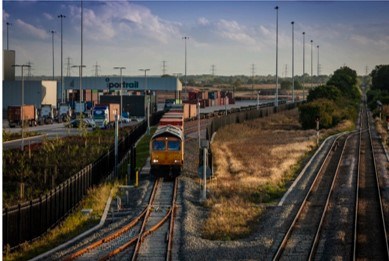
Future guiding mind for rail seeks views on how to grow freight to reduce road congestion and carbon emissions
- Rail freight could need to treble in UK to meet net zero ambition
- Billions in benefits to UK economy could be realised by moving more freight to rail
- Call for evidence open now for 12 weeks
The future guiding mind for Britain’s railways has launched a call for evidence to get views from businesses on how to increase the amount of freight that is moved by rail.
This growth would decarbonise the nation’s logistics chains and get lorries off roads. The Great British Railways Transition Team (GBRTT) wants views and ideas from the widest possible range of stakeholders within and beyond the rail and logistics sectors on how to expand rail freight.
It is estimated rail freight currently accounts for just 10% of surface freight but delivers social and economic benefits worth £2.5 billion to the UK each year. More than 60% of these benefits are realised in former industrial heartlands. Rail freight trains generate about 76% less carbon emissions compared to HGVs per tonne of goods transported.
A freight growth target will act as a catalyst for investment in the rail freight sector by setting a clear government ambition for growth. It will help to highlight the role of freight on the rail network, giving confidence to the sector’s customers and investors. In doing so it will help meet the country’s ambitious greenhouse gas reduction targets and reduce the number of lorries on the road.
If rail freight volumes treble by 2050, as modelling indicates could be required to meet the net-zero targets, then there would be about 14 million fewer road lorry movements a year than today.
Rail Minister, Wendy Morton said:
“With freight playing a significant role in removing emissions from our transport network, this new growth target will be vital for creating a greener freight network as we continue to strive towards net zero.”
Helen McAllister, Programme Director for Freight Reform at GBRTT, said:
“Freight trains have a key role to play in a decarbonised logistics system, and there’s scope for the railway to do even more.
“Research suggests we could need to treble the amount of freight carried by rail to help meet net zero commitments. This would also cut road congestion for drivers and boost the economy.
“This call for evidence will help us understand how much of the current and future market demand for freight could be met by rail, how we can make it even more efficient and sustainable and how we can connect to new customers.”
Kate Jennings, Policy Director at Logistics UK said:
“When passenger numbers dropped as a result of the COVID-19 pandemic, focus across the rail industry shifted to rail freight. But now, with passenger numbers returning, our sector will require support and investment to respond to customer demand. Logistics UK welcomes the Government’s commitment to establishing a rail freight growth target and is urging its members to respond to this Call for Evidence to ensure the resulting plans for the future of rail freight are clear and ambitious.”
The Plan for Rail recommended the establishment of a new, public rail body: Great British Railways (GBR). The Great British Railways Transition Team has been set up to establish GBR. One of the Plan for Rail’s core commitments is that the Government will set a rail freight growth target. GBRTT’s call for evidence will be used to inform this. The target will complement existing and future targets set by Scottish Ministers in Scotland, and magnify the impact of rail freight growth nationwide.
The call for evidence will help GBRTT to understand the realistic volume of goods that could be transferred to rail; where the potential for future rail freight traffic exists and where new rail terminals could be needed. This builds on the Department for Transport and Industry’s joint Future of Freight long-term plan, published in early June. The plan highlighted the role rail freight and mode shift plays in enabling an efficient, resilient, reliable, and sustainable freight and logistics sector. Both documents recognise and promote the need for rail to be part of an integrated, multimodal logistics system. The call for evidence is a pivotal next step in achieving our mode shift ambitions.
This call for evidence launches on 5 July 2022 and will be open for 12 weeks, until 27 September 2022.
Notes to editors
- GBRTT welcomes individual responses or those on behalf of an organisation or organisations. The call for evidence presents a fantastic opportunity to not only seek the views of existing rail freight customers and stakeholders across the wider rail industry, but also crucially to reach an entirely new audience of potential rail freight customers.
- GBRTT welcomes all views on rail freight growth, which can be submitted online via a dedicated webpage [Rail Freight Growth Target | Great British Railways Transition Team (gbrtt.co.uk)] or by email to RFGTcallforevidence@gbrtt.co.uk using the response template, which is available to download on the call for evidence webpage.
